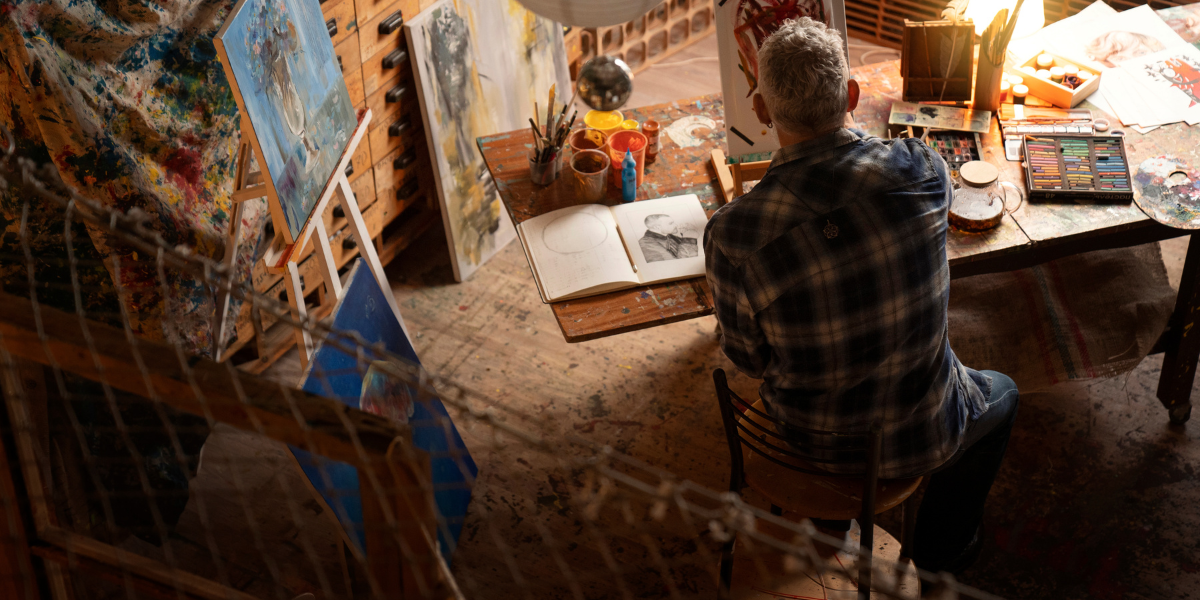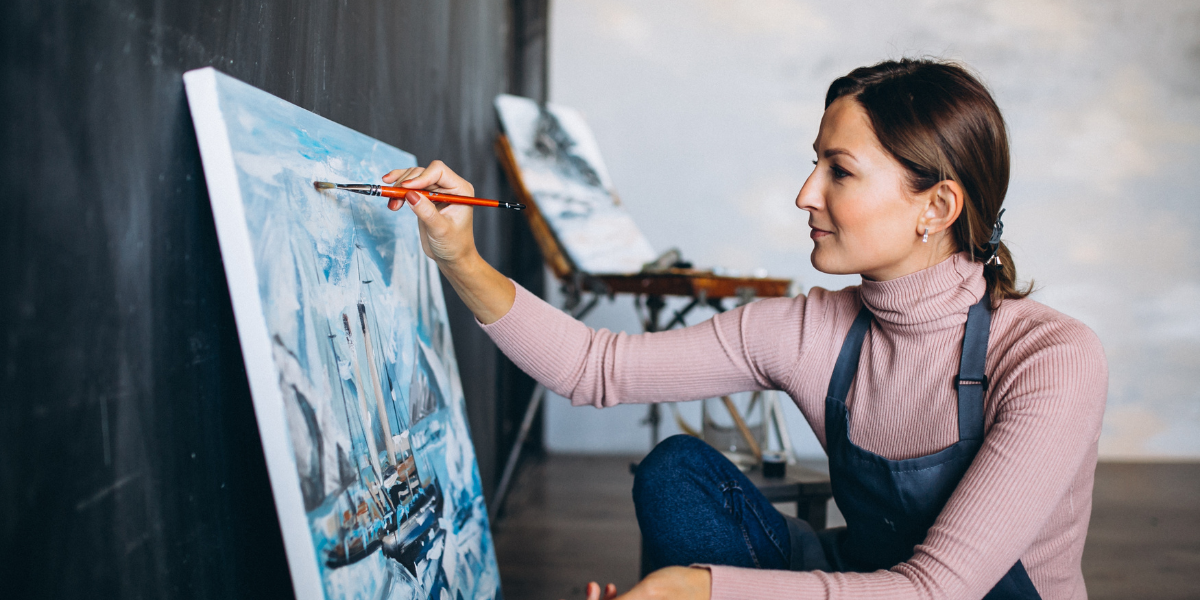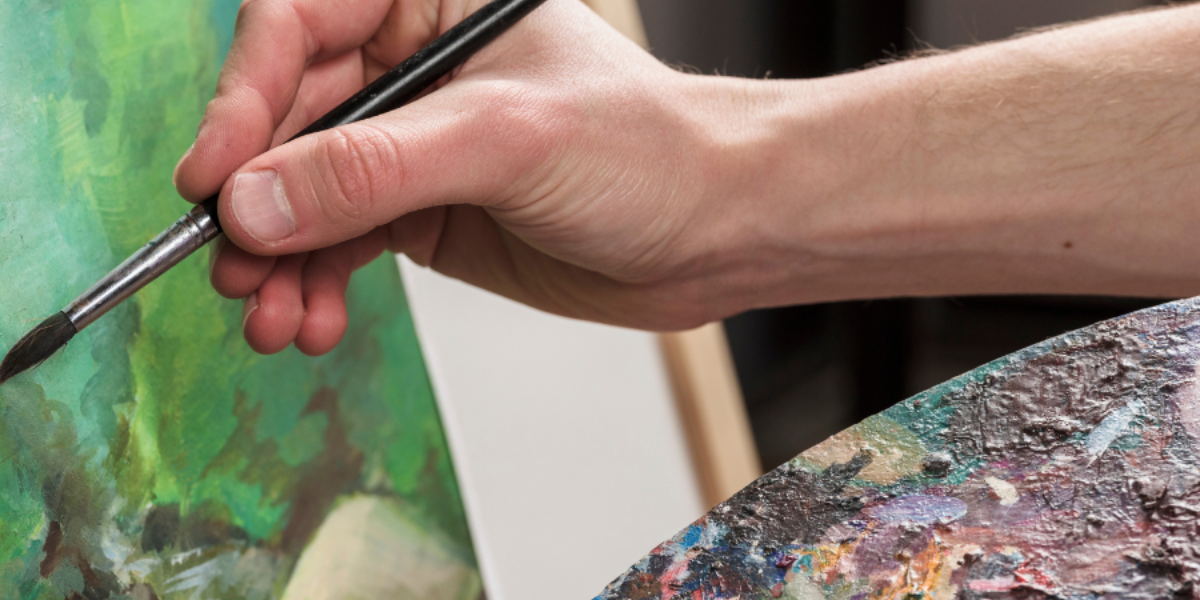Art is Personal Unlike generic gifts, art can be deeply personalized. A painting can reflect a person’s personality, memories, values, or aspirations. Whether it’s a serene landscape for a peace-loving soul or a vibrant abstract for someone full of life, choosing a piece that resonates with the recipient’s taste makes the gift truly meaningful. You’re not just giving an object — you’re giving a story, an emotion, and a connection. It Beautifies the Space Everyone wants a beautiful space. Whether it’s a new home, an office makeover, or a nursery for a newborn, art instantly elevates the environment. A well-chosen painting can complement the interior, add color to empty walls, and create a warm, inviting atmosphere. Unlike decor that gets outdated quickly, timeless art grows with the space and becomes a part of daily life. It’s Thoughtful and Unique Let’s face it — most people don’t remember who gave them the third set of towels or a gift card. But they will remember a painting that sits on their wall for years. Art shows thought. It says, “I know you, I value you, and I want to give you something meaningful.” When you choose art as a gift, you’re giving something no one else can replicate. Art Fits All Occasions From joyful milestones to emotional moments, art is a perfect companion for any life event: A Great Corporate or Professional Gift Looking for a gift that’s elegant yet personal for a client, colleague, or mentor? A framed painting or limited-edition print makes a sophisticated statement. It conveys professionalism while also standing out from the usual corporate gifting items. It Supports Artists and Culture Gifting art doesn’t just make your recipient happy — it also supports independent artists. When you buy from platforms like Colortan, you’re investing in creativity and helping artists grow their passion and livelihood. It’s a gift that creates a ripple effect — spreading value across communities and cultures. Easy to Order, Pack, and Send Thanks to modern online galleries, gifting art is now convenient. With Colortan, you can: It’s an effortless process with a deeply meaningful result. It Lasts a Lifetime While other gifts are consumed, replaced, or forgotten, a painting becomes a part of someone’s life. It’s seen every day. It sparks memories. It stays. That’s the true magic of art — it lives on, long after the moment has passed.
How We Curate Art at Colortan
Our Philosophy: Art With Meaning We don’t just choose what looks good. We select what feels right. Every painting we feature must have a voice — a story behind it, a vision from the artist, and a resonance with the viewer. Whether it’s a traditional landscape or a modern abstract, the goal is the same: to evoke emotion and connection. We aim to make art accessible to everyone — from seasoned collectors to first-time buyers. And that means offering a diverse, inclusive collection that reflects both tradition and innovation. Connecting with Artists Worldwide Colortan works closely with emerging and established artists from around the globe. We seek creators who are passionate, original, and authentic in their work. Our curation team constantly scouts for new voices — whether it’s a rural folk artist in India, a bold street artist from Brazil, or a digital surrealist from Europe. We focus on artists who: Every artist we feature is interviewed, reviewed, and welcomed into our growing community with respect and support. A Thoughtful Selection Process Our art curation process is guided by a team of experienced curators, designers, and art lovers. Here’s how it works: Step 1: Portfolio Review We assess an artist’s body of work, examining consistency, originality, and emotional impact. Step 2: Theme and Relevance We consider how the artwork fits into current collections — whether it supports a seasonal theme, a popular interior trend, or a cultural celebration. Step 3: Quality Check We inspect the materials used, the finish of the work, and overall presentation. Only paintings that meet high standards of quality are approved for sale. Step 4: Feedback Loop We also listen to what you, the customers, love most — and adjust our collections based on your preferences, reviews, and demand. Offering Variety and Balance Our collections aim to represent: Whether you’re looking for a large statement piece or a set of smaller canvases for a gallery wall, you’ll find something curated just for you. Exclusive & Limited Edition Works Some of our pieces are exclusive to Colortan, meaning you won’t find them anywhere else. We also offer limited edition prints that are numbered, signed, and only produced in small batches — preserving their value and uniqueness. Continuous Dialogue with Our Artists Our work doesn’t stop after listing a painting. We stay in constant touch with our artists — offering feedback, helping them grow, and collaborating on new collections. This two-way relationship helps us stay creative, responsive, and relevant.
Understanding Art Mediums: Oil, Acrylic, and Watercolor
Oil Paintings: Rich, Timeless, and Luxurious What Is It? Oil paint is made by mixing pigment with oil (typically linseed oil), which allows it to dry slowly. This slow-drying process gives artists time to layer and blend colors with incredible detail. Characteristics: Ideal For: Care Tips: Acrylic Paintings: Bold, Modern, and Versatile What Is It? Acrylic paint is water-based and dries quickly. It became popular in the 20th century due to its versatility and ease of use. Acrylic can mimic both oil and watercolor effects, depending on how it’s applied. Characteristics: Ideal For: Care Tips: Watercolor Paintings: Soft, Delicate, and Atmospheri What Is It? Watercolor is created by mixing pigment with water and applying it to paper. It’s known for its transparency and fluidity, making it perfect for capturing light and subtle tones. Characteristics: Ideal For: Care Tips:
How to Care for and Preserve Your Paintings
Control the Environment Avoid Direct Sunlight Sunlight is the number one enemy of paintings. Prolonged exposure to UV rays can cause colors to fade and canvas to weaken. Always hang your artwork away from windows or use UV-filtering glass when framing. Monitor Temperature and Humidity Paintings, especially those on canvas or wood, are sensitive to temperature and humidity fluctuations. Excess heat can cause cracking, while high humidity can lead to mold or warping. Best conditions: Keep Away from Vents and Fireplaces Avoid placing paintings near heaters, air conditioners, or fireplaces. The continuous heat or airflow can dry out paint, stretch canvas, or cause structural damage. Cleaning Your Paintings Safely Dusting Use a soft, dry microfiber cloth or a clean artist’s brush to gently dust the surface. Always dust with light pressure and never use water or sprays directly on the painting. Avoid Chemical Cleaners Never use household cleaners, polishes, or glass cleaner near artwork. These can strip the paint, damage varnish, or stain the canvas. Cleaning Framed Paintings If your painting is framed under glass, use a soft cloth with glass cleaner — but spray the cloth, not the glass. Avoid letting moisture seep into the frame Framing for Protection Use Protective Glass For valuable or delicate works, consider UV-protective glass or museum-grade acrylic. This blocks harmful rays and helps reduce glare. Choose Acid-Free Materials Make sure the frame backing, matting, and mounting materials are acid-free to avoid yellowing or degrading the painting over time. Secure the Frame Use strong, rust-proof hangers and wall anchors. Loose frames can allow dust in or cause ac Rotate and Reposition Periodically Even with great care, constant exposure to the same environment can cause stress on certain areas of a painting. Consider rotating your artwork every year or so. This also gives you the joy of refreshing your decor without buying Handling and Transporting Paintings For antique or highly valuable paintings, consult a professional conservator every few years for inspection or cleaning. They use advanced techniques to restore color, remove dirt buildup, and re-stretch canvases if needed. What to Avoid at All Costs
How Emerging Artists Are Shaping the Future of Modern Art
The Shift in Artistic Expression Modern art has always been about breaking boundaries — and emerging artists are pushing them even further. These creators are less concerned with following tradition and more interested in expressing authenticity. From digital painting to recycled material collages, today’s artists are expanding the definition of “painting” itself. They blur the lines between disciplines — mixing photography, sculpture, street art, and even technology. They talk about mental health, climate change, social justice, identity, and more — proving that art isn’t just visual; it’s visceral, political, emotional, and global. Diversity and Cultural Influence One of the most exciting aspects of emerging art today is its cultural richness. Young artists from India, Africa, Latin America, Southeast Asia, and Indigenous communities are finally receiving the recognition they deserve. Their stories, techniques, and traditions bring authenticity to a modern world that craves connection. Unlike older generations who often had to adapt their style to Western tastes, today’s artists are proudly embracing their heritage and reinventing it with a contemporary lens. The result? A colorful, powerful movement where folk meets future. The Rise of Digital Platforms In the past, gaining exposure meant being accepted into a gallery or museum. But today, thanks to painting-selling websites like Colortan, social media, and digital exhibitions, emerging artists can reach global audiences without gatekeepers. These platforms give new talent a chance to be discovered — and give buyers access to affordable, original, and deeply meaningful artwork. Whether it’s a 20-year-old self-taught painter from Mumbai or a digital surrealist from Nairobi, the internet is helping uncover voices that would otherwise remain hidden. Art as Commentary and Healing Many new artists are using their work as a tool for reflection and healing. Themes like mental wellness, self-identity, and resilience are explored in colorful, abstract, and symbolic ways. Art becomes therapy, both for the creator and the viewer. This shift toward “art with meaning” is resonating with younger audiences who want more than decorative art — they want art that speaks, heals, and provokes. Experimental Techniques and Materials Emerging artists are fearless when it comes to experimenting. Some paint with coffee and clay, others use AI, projection mapping, or upcycled textiles. The fusion of technology with tradition is opening doors to new mediums and aesthetics never seen before. Art is no longer confined to a flat canvas. It’s alive — growing on walls, moving through screens, or building interactive experiences. How Buyers Can Support the Future Supporting emerging artists doesn’t require millions. It starts with appreciation, visibility, and small purchases that help artists grow their careers. Buying from trusted platforms like Colortan, which highlight and empower new talent, is one of the best ways to directly contribute to the future of modern art. Collectors also have the chance to invest early — discovering talent before they become household names. Final Thoughts The future of modern art lies in the hands of these bold, creative minds who are reimagining what art can be. They are rewriting the rules, bringing marginalized voices to the forefront, and making art more inclusive, accessible, and impactful. If you’re looking to bring home a painting that speaks to the future — in message, medium, or meaning — look no further than today’s emerging artists. Their stories are just beginning, and your walls could be part of their journey.
How to Frame and Display Your Paintings Right
A frame isn’t just a boundary — it’s a bridge between the painting and your interior. The right frame can make colors pop, give structure to free-flowing designs, and add elegance to minimalist work. Most importantly, a good frame provides protection from dust, humidity, and accidental damage. Choosing the Right Frame for Your Painting Match the Style of the Painting Consider Your Interior Decor Match your frame not only to the painting but also to your room’s theme. A modern glass frame might look out of place in a vintage room, just as an antique frame may overpower a clean, minimal wall. Frame Size and Proportion Avoid oversized frames for small paintings and vice versa. A frame should enhance, not dominate. If the painting is small, consider using a wide mat (the white space between the painting and the frame) to give it more visual impact. Displaying Your Painting: Where and How to Ha Eye-Level Rule Hang your painting so its center is at eye level — typically around 57 to 60 inches from the floor. This ensures natural viewing and a balanced aesthetic. Avoid Direct Sunlight Paintings, especially those with delicate pigments, can fade over time when exposed to sunlight. Choose a shaded area or use UV-protected glass if sunlight is unavoidable. Think About Lighting Good lighting elevates any artwork. Use focused spotlights or picture lights to highlight key pieces, especially in living rooms, hallways, or above fireplaces. Create a Gallery Wall Mix different sizes and frame styles for a more personal, curated look. Layout your arrangement on the floor before you hang it. Keep consistent spacing for a clean finish. Caring for Your Framed Painting Final Tips for a Perfect Display
Bring Art Into Your Life
Introduction: The New Age of Art Collecting Art is no longer confined to galleries and museums. In today’s digital world, buying and collecting paintings has become easier, more accessible, and deeply personal. Painting selling websites have opened the door for anyone to own a piece of art that speaks to their heart, matches their decor, or adds meaning to their space. Whether you’re a first-time buyer or a seasoned collector, this guide will walk you through everything you need to know about navigating the world of online art. The Emotional Power of Paintings Art Speaks When Words Fall Short Paintings evoke emotions in ways words often can’t. A single brushstroke can express joy, pain, nostalgia, or freedom. When you find a painting that resonates with you, it becomes more than decor; it becomes a personal connection. Creating Atmosphere Art sets the tone for a space. Abstracts can energize a room, landscapes can calm the mind, and portraits can make a space feel lived-in and intimate. Choosing the right painting can shape the mood of any room in your home. Expressing Identity Your choice of art reflects who you are. Whether you love bold colors, minimalism, nature, or traditional motifs, your walls tell your story. Understanding Art Styles Abstract Art Non-representational and expressive, abstract art uses colors, lines, and shapes to evoke emotions and ideas. Perfect for modern homes. Realism These paintings portray the world as it is. Realist art includes portraits, still life, and landscapes that are incredibly detailed and lifelike. Impressionism Soft colors and visible brush strokes make this style ideal for those who love dreamy, romantic aesthetics. Contemporary Art Fresh, experimental, and often socially aware, contemporary paintings push boundaries and challenge traditional forms. Traditional and Folk Art Cultural heritage comes alive in these pieces. Indian Madhubani, Warli, African tribal art, and Native American patterns are just a few examples. Choosing the Right Painting for Your Space Consider the Room Match the mood: calming art for bedrooms, energizing pieces for workspaces, and conversation-starters for living rooms. Size Matters A large canvas can dominate a wall and become the centerpiece. Smaller pieces are perfect for intimate corners and galleries. Color Coordination Complement or contrast with existing furniture and wall color. A bold piece can bring a neutral room to life. Framing and Presentation Choose frames that enhance the artwork. Minimalist frames work well with modern pieces, while ornate frames suit classical styles. Why Buy Art Online? Accessibility Online galleries are open 24/7. Browse hundreds of artworks from your home without time or location constraints. Variety Find a broader range of artists, styles, and price points online than most physical galleries can offer. Artist Support Many online platforms directly support independent artists. Your purchase helps creative professionals thrive. Secure Payment and Delivery Reputable painting websites offer encrypted payment methods and reliable delivery, ensuring a safe and smooth buying experience. Tips for Buying Paintings Online Read Descriptions Carefully Understand the medium (oil, acrylic, watercolor), size, and canvas type before purchasing. Verify Authenticity Look for certificates of authenticity or direct artist verification. Check Reviews User reviews give insight into painting quality, packaging, and customer service. Understand Return Policies Choose websites with clear and fair return or exchange policies. Decorating with Paintings Creating a Gallery Wall Combine various sizes, frames, and styles for a curated gallery wall. Plan layout before drilling! Art as a Focal Point Use one large painting to anchor a room’s design. Place it above a sofa, bed, or fireplace. Themed Collections Group paintings by color, subject, or artist for a cohesive look. Mixing Mediums Pair paintings with wall sculptures, mirrors, or photography to add texture and variety. Caring for Your Paintings Placement Avoid direct sunlight and humid areas. Keep art away from heaters and vents. Cleaning Dust gently with a dry microfiber cloth. Avoid chemicals or water. Framing with Glass Use UV-protective glass for delicate works or valuable pieces. The Rise of Digital and Print Art Affordable Alternatives High-quality prints offer budget-friendly ways to enjoy art. Customization Digital art can often be customized in color, size, or message. Limited Editions Numbered, signed prints retain value and collectability.
The Ultimate Guide to Choosing and Buying Paintings Online
Introduction: The Power of Art in Everyday Life Art has always been more than decoration. It is emotion made visible — a form of expression that speaks directly to the soul. In today’s fast-paced digital world, paintings offer a sense of grounding, identity, and warmth. Whether it’s the quiet calm of a pastel landscape or the vibrant energy of abstract colors, paintings transform spaces into experiences. With the rise of online galleries, discovering and purchasing meaningful art has never been more accessible. Platforms like Colortan have opened doors for people everywhere to explore unique pieces from emerging and established artists around the globe. Buying art online is no longer limited to collectors and interior designers — it’s a personal, enriching journey open to all. In this guide, we’ll walk you through everything you need to know about choosing, buying, and displaying paintings, ensuring that every wall in your home reflects your personality, passion, and style. Why Paintings Matter in Modern Spaces More Than Just Décor When you place a painting in a room, you’re not just filling a blank space — you’re creating a focal point that tells a story. A painting can elevate a plain wall into a conversation starter. It adds depth, character, and a layer of intimacy that mass-produced decorations often lack. Whether you live in a high-rise apartment, a cozy studio, or a large family home, the right painting can instantly transform your environment. Reflecting Your Identity Just as clothing expresses your personal style, art reveals your inner world. The pieces you choose reflect your taste, emotions, and sometimes even your values. A bold, chaotic abstract might signal a love for freedom and expression. A serene watercolor might show your affinity for peace and simplicity. Every choice of art is an extension of your personality. Emotional Influence and Mood Setting The psychological impact of art on mood is well-documented. Warm hues like red, orange, and yellow can bring energy and excitement into a space. Cooler tones like blue and green foster calmness and clarity. Choosing a painting based on emotional response is a powerful way to craft the atmosphere of your home. Imagine walking into a room that instantly soothes your mind after a long day — that’s the magic a well-placed painting can offer. Whether you’re setting the tone in a bedroom, energizing a workspace, or adding charm to a hallway, paintings are silent but strong emotional anchors. Cultural and Artistic Value Paintings connect us to traditions, cultures, and stories. A canvas depicting Indian folk art, African tribal patterns, or European landscapes brings cultural richness into your home. Displaying such art is not just about beauty — it’s about respect, curiosity, and dialogue between histories and identities. A Long-Term Visual Investment Unlike temporary décor items that fade with trends, paintings endure. A high-quality artwork becomes part of your daily life for years, even decades. Some become heirlooms. Others appreciate in monetary value. But all gain personal value — because you live with them, day after day, memory after memory. Understanding Painting Styles Abstract Art Expressive, vibrant, and often thought-provoking. Abstracts rely on shape, color, and texture rather than realistic forms, making them perfect for modern or minimalist homes. Realism and Portraits Ideal for traditional spaces, these works often depict life-like human figures or historical scenes. They bring character and storytelling into a room. Landscape Paintings Nature-based art brings the outside in, providing serenity and a sense of openness. Ideal for bedrooms, offices, or reading corners. Cultural and Ethnic Art Showcasing heritage and identity, cultural art ranges from tribal prints to traditional Indian, African, or Japanese styles. It adds uniqueness and authenticity to your space.








